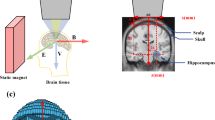Abstract
A first approximation model, which accounts for the strongest phenomena defining kindling is suggested. It is based on an excitatory-inhibitory coupling of neural aggregates, to which a self-stimulation element for the excitatory aggregate was added. The functional linking hypothesis views the representation of kindling as a process of gradual transition through structural changes from a stable system to a system showing stability for small perturbations and an oscillatory orbit for larger perturbations, to a purely oscillatory system. The anatomical linking hypothesis views the excitatory aggregate as representing the hypothalamus, the inhibitory aggregate as representing the hippocampal-septal-preoptic complex, and the selfstimulating element of the excitatory aggregate as representing the amygdaloid-pyriform complex. The model was realized on a digital computer with graphic capabilities and showed good qualitative agreement with the experimental data related to kindling. In addition, the use of the model for generating new experiments is discussed.
Similar content being viewed by others
References
Ahn, S.M., Freeman, W.J.: Steady state and limit cycle activity of a mass of neurons forming simple feedback loops(1): lumped circuit model. Kybernetik 16, 87–91 (1974)
Amari, S.: Characteristics of randomly connected threshold element networks and network systems. Proceedings of IEEE 59, 35–47 (1971)
Amari, S.: Characteristics of random nets of analog neuron-like elements. IEEE Transactions on Systems, Man, and Cybernetics SMC 2, 643–657 (1972)
Arduini, A., Lairy-Bouns, G.C.: Action de la stimulation electrique de la formation reticulaire du bulbe et des stimulations sensorielles sur les ondes electriques. EEG Clin. Neurophysiol. 4, 503–512 (1952)
Chorover, S.L., DeLuca, A.M.: Transient changes in electrographic reaction to ECS in the rat following footshock. J. Comp. Physiol. Psychology 69, 141–149 (1969)
Feldman, J.L., Cowan, J.D.: Large-scale activity in neural nets 11: a model for brainstem respiratory oscillator. Biol. Cybernetics 17, 39–51 (1975)
Goddard, G.V., McIntyre, D.C., Leech, C.K.: A permanent change in brain function resulting from daily electrical stimulation. Exp. Neur. 25, 295–330 (1969)
Kilmer, W.L., Lieblich, I., Probert, T.: Two time-domain oscillatory brain models for psychologists, In: Systems Neuroscience, Metzler, J., ed. New York: Academic Press 1977
Leolla, W.P.: Control of skeletal motor activity, with emphasis on the role of diencephalic mechanisms, In. The Hypothalamus, Haymaker, W., Anderson, E., Nauta, W.J.H., eds. Springfield: C.C. Thomas 1969
Lieblich, I., Guttman, R.: The relation between motor activity and risk of death in audiogenic seizures of DBA mice. Life Sci. 4, 2295–2299 (1965)
Lieblich, I., Yitzhaki, J., Cohen, E.: Effects of septal lesions on behavior elicited by stimulation of the amygdaloid complex. Behav. Biol. 17, 1–16 (1976)
Morrell, F., Tsuru, N. Kindling in the frog: Development of spontaneous epileptiform activity. Electroenceph. Clin. Neurophysiol. 40, 1–11 (1976)
Nauta, W.J.H., Haymaker, W.: Hypothalamic nuclei and fiber connections, In: The Hypothalamus. Haymaker, W., Anderson, E., Nauta, W.J.H., eds. Springfield: C. C. Thomas 1969
Pinel, J.P.J., Phillips, A.G., McNeill, B.: Blockage of highly stable kindled seizures in rats by antecedant footshock. Epilepsia 14, 29 (1973)
Rabenstein, A.L.: Introduction to ordinary differential equations. New York: Academic Press 1966
Racine, D., Newberry, F., Burnham, W.M.: Post-activation potentiation and the kindling phenomenon. EEG and Clin. Neurophysiol. 39, 261–271 (1975)
Roelofs, G.A.: Behavioral state and seizure susceptibility in cats: a study of responses to electrical stimulation of the basal temporal lobe in cats under different behavioral conditions. Acta Neurol. Scand. 43, Suppl. 26 (1967)
Thom, R.: Stabilitees structurelles et morphogeneses. Reading, MA: Benjamin 1972
Author information
Authors and Affiliations
Rights and permissions
About this article
Cite this article
Lieblich, I., Amari, S. An extended first approximation model for the amygdaloid kindling phenomenon. Biol. Cybernetics 28, 129–135 (1978). https://doi.org/10.1007/BF00337134
Received:
Issue Date:
DOI: https://doi.org/10.1007/BF00337134




